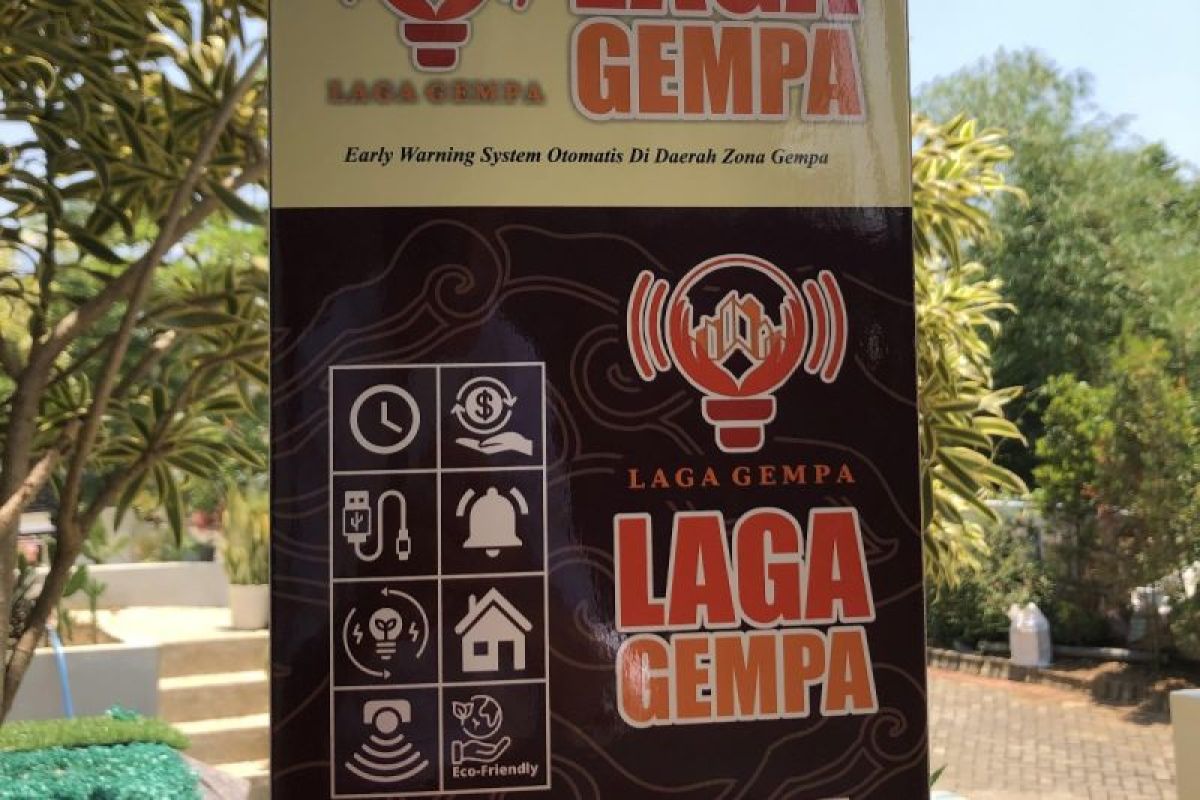Brawijaya University (Unibraw) in East Java stated that its engineering students have successfully made earthquake emergency lights that can be used as an early warning system in earthquake-prone regions.
The lamps, named after LAGA GEMPA, are equipped with rechargeable Li-ion 18650 batteries, with a capacity of 13,000 milliampere-hour (mAh), the Unibraw's LAGA GEMPA Innovation team leader, Yusuf Yuaniar, said.
"These lamps can be turned on for the whole day and recharged for eight hours," he remarked here, Wednesday (September 27).
In conducting their innovation work, the team members were funded by the Education, Culture, Research and Technology Ministry, he noted, adding that he did the work along with three other engineering students.
They are Cyril Wahyu Dwi Anugrah and M. Fajar Arif from the Electrical Engineering branch and Deca Melani from Regional and City Planning.
According to Yuaniar, the lamps' alarm sounds that are audible from up to three sleeping rooms would hopefully enable people to take immediate rescue efforts. Hence, the number of fatalities can be minimized.
The lamps have been sold to several cities in Indonesia, including Malang, Probolinggo, Cianjur, and Yogyakarta. The buyers comprise education institutions and rented houses, he stated.
"We open preorders, and the products have been sold through freelancers in Aceh Province as well as the cities of Yogyakarta, Lombok, Bogor, Probolinggo, and Malang and its outskirts," he said.
Sold at Rp400 thousand (around US$25) per piece, the lamps could detect the tremors of mild, moderate, and strong magnitude of earthquakes and produce different alarm sounds, he remarked.
As part of the students' innovative products, this earthquake emergency light was sent to the National Students' Science Week (Pimnas), an annual national contest to examine Indonesian students' creativity, he said.
Earthquakes regularly rock various parts of Indonesia since the country lies on the Circum-Pacific Belt, also known as the Ring of Fire, where several tectonic plates meet and cause frequent volcanic and seismic activities.
Aceh experienced the deadliest ever earthquake followed by a tsunami on December 26, 2004. The catastrophe that also affected certain coastal areas in countries, such as Thailand, Sri Lanka, and India, reportedly killed some 230 thousand people.
Another deadly earthquake to have rattled Indonesia was in West Sulawesi Province on January 15, 2021.
This 6.2-magnitude earthquake, ensued by several aftershocks, jolted the districts of Mamuju and Majene, claiming more than 100 lives and destroyed several buildings.
Sulawesi Island has repeatedly borne witness to deadly earthquakes. On September 28, 2018, for instance, a 7.4-magnitude earthquake hit several parts of Central Sulawesi Province.
The strong earthquake that was followed by a tsunami and soil liquefaction in Palu, the capital of Central Sulawesi Province, claimed 2,102 lives, injured 4,612, and rendered 680 others missing.
A total of 68,451 homes incurred serious damage, while 78,994 people were displaced.
COPYRIGHT © ANTARA News Jawa Timur 2023
The lamps, named after LAGA GEMPA, are equipped with rechargeable Li-ion 18650 batteries, with a capacity of 13,000 milliampere-hour (mAh), the Unibraw's LAGA GEMPA Innovation team leader, Yusuf Yuaniar, said.
"These lamps can be turned on for the whole day and recharged for eight hours," he remarked here, Wednesday (September 27).
In conducting their innovation work, the team members were funded by the Education, Culture, Research and Technology Ministry, he noted, adding that he did the work along with three other engineering students.
They are Cyril Wahyu Dwi Anugrah and M. Fajar Arif from the Electrical Engineering branch and Deca Melani from Regional and City Planning.
According to Yuaniar, the lamps' alarm sounds that are audible from up to three sleeping rooms would hopefully enable people to take immediate rescue efforts. Hence, the number of fatalities can be minimized.
The lamps have been sold to several cities in Indonesia, including Malang, Probolinggo, Cianjur, and Yogyakarta. The buyers comprise education institutions and rented houses, he stated.
"We open preorders, and the products have been sold through freelancers in Aceh Province as well as the cities of Yogyakarta, Lombok, Bogor, Probolinggo, and Malang and its outskirts," he said.
Sold at Rp400 thousand (around US$25) per piece, the lamps could detect the tremors of mild, moderate, and strong magnitude of earthquakes and produce different alarm sounds, he remarked.
As part of the students' innovative products, this earthquake emergency light was sent to the National Students' Science Week (Pimnas), an annual national contest to examine Indonesian students' creativity, he said.
Earthquakes regularly rock various parts of Indonesia since the country lies on the Circum-Pacific Belt, also known as the Ring of Fire, where several tectonic plates meet and cause frequent volcanic and seismic activities.
Aceh experienced the deadliest ever earthquake followed by a tsunami on December 26, 2004. The catastrophe that also affected certain coastal areas in countries, such as Thailand, Sri Lanka, and India, reportedly killed some 230 thousand people.
Another deadly earthquake to have rattled Indonesia was in West Sulawesi Province on January 15, 2021.
This 6.2-magnitude earthquake, ensued by several aftershocks, jolted the districts of Mamuju and Majene, claiming more than 100 lives and destroyed several buildings.
Sulawesi Island has repeatedly borne witness to deadly earthquakes. On September 28, 2018, for instance, a 7.4-magnitude earthquake hit several parts of Central Sulawesi Province.
The strong earthquake that was followed by a tsunami and soil liquefaction in Palu, the capital of Central Sulawesi Province, claimed 2,102 lives, injured 4,612, and rendered 680 others missing.
A total of 68,451 homes incurred serious damage, while 78,994 people were displaced.
Editor : Abdullah Rifai
COPYRIGHT © ANTARA News Jawa Timur 2023

